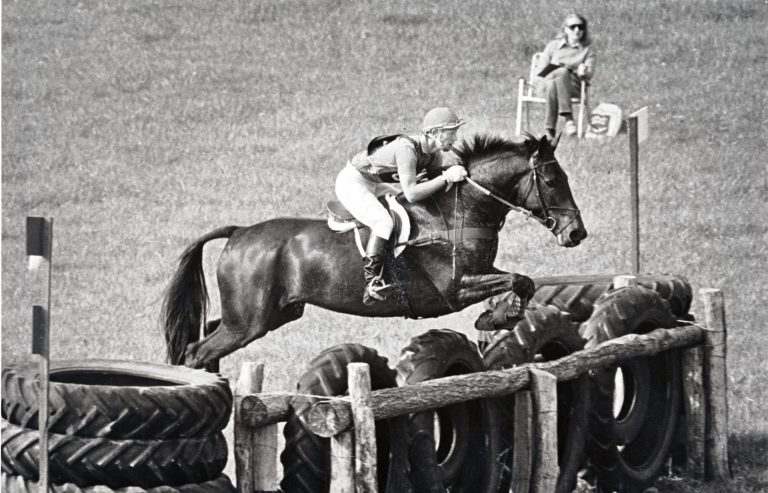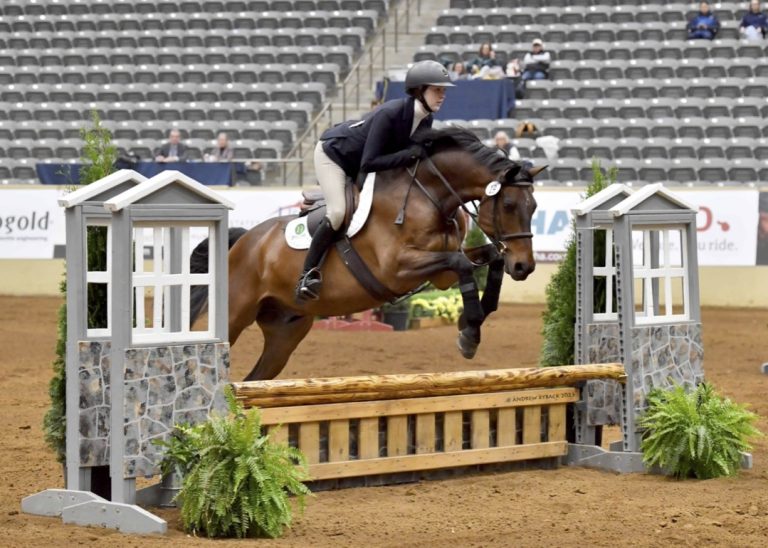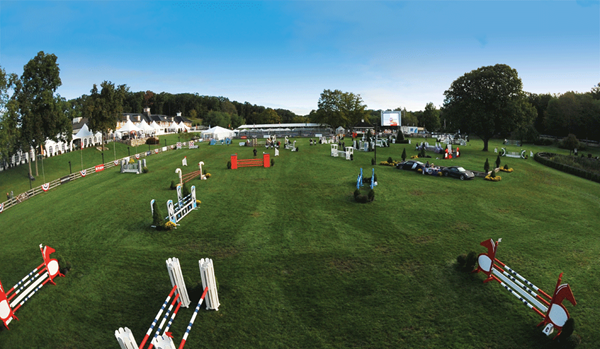 Old Salem Farm, which hosted its first horse show in 1967, now hosts the American Gold Cup, a leg of the Longines FEI World CupTM Jumping North American League. | © The Book LLC
Old Salem Farm, which hosted its first horse show in 1967, now hosts the American Gold Cup, a leg of the Longines FEI World CupTM Jumping North American League. | © The Book LLCOld Salem Farm, one of the most iconic horse-show venues in the country, has fostered dreams, both large and small, for more than half a century. Located in North Salem, New York, only an hour from New York City, the beautiful, 120-acre property graced by a magnificent 85,000-square-foot barn set on the top of a hill has served as a base for a long list of famous—and infamous—trainers. Hosting everything from local shows to international events, it’s long been a popular destination for spotting equestrian and non-equestrian celebrities. The property itself has been the focus of many grand plans and extravagant investments—some of which panned out and many of which did not—and, at times, more than a whiff of scandal.
A group of retired policemen, led by North Salem resident Frank Amendola, built the original barn in 1964 with the intention of creating a profitable boarding and showing business. They named it Salem View Farms. “How they ever got into that business I don’t know,” says Carol Goldberg, who worked for a local trainer at the time. “They knew nothing about horses.”
Frank and his fellow investors did know enough to consult an expert, George Morris, for input. “They were building a fabulous place and asked me to come on board,” George remembers. “I turned professional at the beginning of that year and was renting property. So after the National Horse Show, I moved my stable to Salem View. The property was essentially the same as it is today, with the outdoor sand ring, grass field and the way the road comes in with the curve.”
Although George stayed at Salem View for only a year, it was a significant starting point for his training career. “This was the first place I had quite a stable of Junior riders, including Conrad Homfeld, Freddie Bauer and Jen Marsden,” he says. A steady stream of trainers, riders and horse dealers from a variety of disciplines followed, leasing blocks of stalls. “It was like a big horse condo,” says Carol. “Everybody was trying to make a living.”
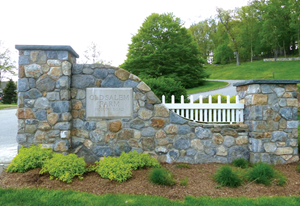 Visitors to Old Salem Farm are greeted with a beautiful entrance and curved drive that leads to the stable. | © The Book LLC
Visitors to Old Salem Farm are greeted with a beautiful entrance and curved drive that leads to the stable. | © The Book LLCThe enormous barn included one of the first indoor arenas in North Salem. Locals could trailer in to use it and they paid by the hour. For trainers struggling to maintain their businesses through the bitter New England winters, Carol says, “It opened up a new world, helped us get horses ready sooner to show or sell.” Frank periodically cleared the jumps out of the arena to host indoor polo matches. He also organized a horse show in the indoor on Easter Sunday in 1967, which became the precursor to the farm’s tremendously popular annual spring show.
Plagued by disorganization, however, Salem View did not generate the revenue its investors hoped for. They sold the property to Dr. Albert Keston in 1967. He renamed it The Hill and continued leasing stalls to multiple trainers. He also hired Jack Rockwell to run the facility and organize local and regional shows there.
Over the next 14 years, The Hill housed “an illustrious crew,” says Carol. Ronnie Mutch was there, “as were my ex-husband, Kent Jungherr, and his brother, Mark. There was a dressage person, too, and Jack Adams ran a sales business.” With all of the different tenants, she says, the facility gradually fell into disrepair.
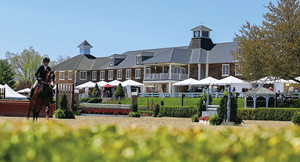 Old Salem Farm’s current owner, Kamran Hakin, has invested more than $30 million in renovations to the facility, including extensive exterior work to the stable and riding arenas. | Courtesy, Lindsay Brock/Jump Media
Old Salem Farm’s current owner, Kamran Hakin, has invested more than $30 million in renovations to the facility, including extensive exterior work to the stable and riding arenas. | Courtesy, Lindsay Brock/Jump MediaThe farm’s current resident trainer, Frank Madden, remembers showing at The Hill in the 1970s. “My fondest recollection was from November 1974. Alex Dunaif had won the ASPCA Maclay Final that year at Madison Square Garden, and I beat her in the Medal class at The Hill. That was an exciting moment for me.” He adds, “It was quite a dilapidated facility back then. It only had one indoor arena and was quite run-down. The condition of the field was, at best, rough, real rough.”
Celebrity Status and Scandal
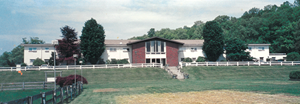 The front of Old Salem Farm as it looked in the 1970s | Courtesy, Old Salem Farm
The front of Old Salem Farm as it looked in the 1970s | Courtesy, Old Salem FarmIn 1981, The Hill enjoyed its first makeover at the hands of new owners, actor Paul Newman and his actress wife, Joanne Woodward, an avid horsewoman. All of their daughters also rode, including Clea, who was a Junior rider at the time, training with Frank, George and Bill Cooney at George’s stable, Hunterdon. Paul and Joanne asked Nick Karazissis to help run the property and renamed it Far West Farms of New York, after his California business. “They did quite a bit to dress it up,” says Frank, “put in a new ring [the grand prix course by famous British course designer Pamela Carruthers], made some real capital improvements.” The couple invested so much in the property that Paul described it in the November 1981 issue of People as “the bottomless pit.”
The horse community loved the renovations. “They were the first people who had the money to make the improvements it needed,” says Carol. “They did a lot of really good things with the place.” During this time, Olympic eventer Michael Page began coaching and training at the farm and the small spring shows became an official annual event.
Hedge-fund manager Paul Greenwood and his wife, Edie, bought the property for $2.1 million in 1984 and renamed it Old Salem Farm. Soon after, Frank and Bill, who’d recently started their own training business, approached Paul about leasing stalls. “There weren’t a lot of options back then,” says Frank. “We always knew that Westchester County was a good place to draw from New York City and that area, so we chose that as a first step of opening up Beacon Hill.
“We weren’t the exclusive trainers at Old Salem,” he continues. “It was a little bit of a communal stable. Charlie Weaver was there for a while. So was Scott Stewart, who was pretty instrumental in bringing Georgina Bloomberg along. Georgina always was and still is a huge fan of Old Salem.” The Greenwoods also sponsored an up-and-coming young rider named Katherine Burdsall. In 1986, they spent the most money ever paid for a jumper at the time, $1 million, on The Natural. He and Katherine went on to win team gold in the 1986 World Championships in Aachen, Germany, and finish first in the 1987 World Cup Finals in Paris, France.
“Paul wanted to take it to the next level,” Frank says. “He started to pick up more dates for one-day shows and bought the farm a brand-new tractor-trailer rig.” In 1986, Paul purchased an adjacent property, expanding the farm’s original 54 acres to 120. Just a few years later, The New York Times called Old Salem Farm “the grandest stable for show horses in the county.” In the same article, a State Department of Agriculture spokesperson said, “Land in Westchester County is probably among the most expensive in the world.”
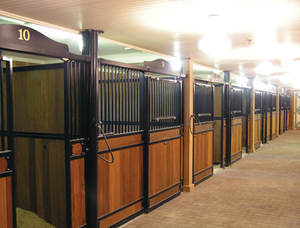 As part of the most recent renovations, the stalls were made in Belgium out of Brazilian teak and ipe wood. | Courtesy, Corton Manufacturing/Horse Stalls USA
As part of the most recent renovations, the stalls were made in Belgium out of Brazilian teak and ipe wood. | Courtesy, Corton Manufacturing/Horse Stalls USAPaul’s lavish lifestyle was later revealed to have been funded by a massive investment fraud and he was sentenced to 10 years in prison in 2014. “You know how they say, ‘Follow the money’?” asks Carol. “In this case, it’s ‘Follow the horses.’”
Under Paul’s ownership, Old Salem’s shows grew in size and scale. He expanded the annual spring show to a weeklong event benefitting Friends of Karen, a charitable organization providing support to children suffering life-threatening illnesses. In 1992, the prestigious Children’s Services Horse Show, which had been held for 41 years at the Farmington Polo Grounds in Connecticut, was moved to Old Salem, to be held back to back with the spring show. With a new major sponsor, PepsiCo, the spring shows were flooded with Pizza Hut, Kentucky Fried Chicken and Taco Bell logos. PepsiCo offered $1 million to any rider who could win the two grands prix held on consecutive Sundays.
Old Salem Farm also hosted the official U.S. Equestrian Team selection trial for the 1990 World Equestrian Games, the 1992 American Horse Shows Association/Miller’s National Hunter Pony and Pony Medal Finals and the 1993 Rolex/USET Medal Finals-East competition.
From a trainer’s perspective, however, Old Salem wasn’t conducive to running a business during this period. “It was just never really complete,” Frank says. “There was very limited housing for grooms, very little office space, limited storage for equipment and shavings. I was there from ’83 to ’88 and ended up moving to an all-inclusive facility.”
Modern-day Makeover
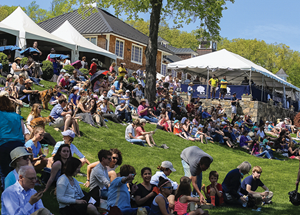 Spectators still catch show-jumping action from the grassy hill in front of the barn adjacent to the grand prix field … | Courtesy, Lindsay Brock/Jump Media
Spectators still catch show-jumping action from the grassy hill in front of the barn adjacent to the grand prix field … | Courtesy, Lindsay Brock/Jump MediaEven with its growing national recognition, Old Salem fell into decline again toward the turn of the century. Billionaire real-estate investor and Iranian immigrant Kamran Hakim, whose children (and now grandchildren) rode horses, partnered with Paul in the late 1990s and then bought him out in 2001. He had great plans to renovate the property, but the project encountered multiple delays in the early years. “I remember going to the May shows at Old Salem and it was completely a construction site,” says Frank. “The building was not able to keep any horses in it.”
Progress resumed when Kamran hired Alan Bietsch to oversee the project. “Alan knew nothing about horses but he’s real skilled when it comes time to get anything done,” says Frank. In the end, Kamran invested more than $30 million in renovations. “It’s just so grand now,” says Frank. “From the stonework, to the copper gutters, to the wood used in the stalls.” Twenty-six stalls will soon be added to the existing 69, which were made in Belgium out of Brazilian teak and ipe wood. The barn includes a boarders’ lounge with a gym. In addition to the beautifully maintained rolling grass grand prix field, the farm has two indoor arenas and five all-weather outdoor rings. The latter have been redone with a drainage mat system and geotextile fibers from Germany.
Five years ago, Kamran invited Frank back to run the training program. Returning to the renovated farm was “a dream come true,” says Frank. “You have everything you could possibly want as a trainer. Not only is everything in terrific shape, you have everything to maintain it as far as equipment. We have a few apartments on the property and additional housing in the surrounding neighborhoods for help.”
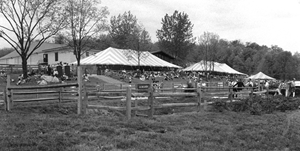 … just as they did in the 1960s and ’70s. Salem View, as the facility originally was named in 1964, was changed to The Hill in 1967. In 1981, it was renamed Far West Farms of New York before being changed to Old Salem Farm in 1984. | Courtesy, Old Salem Farm
… just as they did in the 1960s and ’70s. Salem View, as the facility originally was named in 1964, was changed to The Hill in 1967. In 1981, it was renamed Far West Farms of New York before being changed to Old Salem Farm in 1984. | Courtesy, Old Salem Farm“Kamran’s moved the farm into a whole new, gorgeous, palatial category,” says Carol. “Everything is beautiful, tasteful and run like a well-oiled machine. Every time I drive by, I see landscapers, mowers and people dragging the rings.”
Still closely tied to the local community, Old Salem opens its facility to nearby groups for events. “The Westchester Land Trust had a big gala there recently,” says Carol, “and the North Salem Bridle Trails had an event there.” The Golden’s Bridge Hounds still enjoy access through the back of the property as they have for decades.
Old Salem now hosts 26 shows a year and has partnered with many charities. The two-week annual spring show now offers more than 130 hunter and jumper classes each week, including a total of four grands prix, a USHJA International Hunter Derby and nearly $500,000 in prize money. Now also home to the American Gold Cup (for more, see “Old Salem Gold” on page F7), the farm is bidding to host the 2017 and 2018 FEI Nations CupTM Jumping Finals.
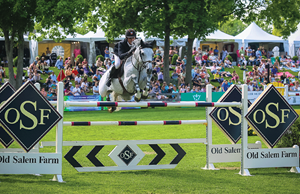 Nick Dello Joio navigates the Old Salem Farm jump. | Courtesy, Lindsay Brock/Jump Media
Nick Dello Joio navigates the Old Salem Farm jump. | Courtesy, Lindsay Brock/Jump MediaCarol describes the show facilities, which can accommodate 1,200 horses and a sizeable trade fair, as a “magnificent ‘tent city.’” Bleachers and a double-decker VIP tent have been added. “We used to sit on the hillside to watch the grand prix field. As the place has improved, the crowds have gotten bigger.” Fiber-optic cables have been installed to facilitate televising of the shows. In 2010, the North American Riders Group voted the spring show one of the top 25 horse shows in America. This year, it voted the American Gold Cup the No. 1 show in the U.S.
With the Gold Cup have come more celebrity-spotting opportunities, ranging from Brian Williams and Tom Selleck, whose daughter, Hannah, rides, to Bruce Springsteen, whose daughter, Jessica, triumphed over Olympic gold medalist Laura Kraut in the Gold Cup last year.
As Old Salem Farm’s shows continue to grow, Frank says, “We’re trying to maintain the different personalities between the shows, but we’re also trying to keep a high standard no matter what show it is, whether it’s local, national or international. I think riders like our attention to detail and aesthetics and scheduling. It’s a little imposing pulling up on this paved driveway through the beautiful automatic gates and then seeing the magnificent barn, but we try to make it feel very user-friendly and welcoming.”
Practical Horseman thanks the North Salem Historical Society for providing background research for this article.
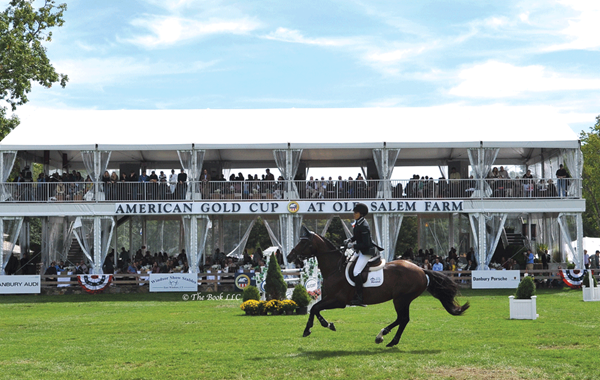 A double-decker VIP tent is installed for the American Gold Cup. | © The Book LLC
A double-decker VIP tent is installed for the American Gold Cup. | © The Book LLC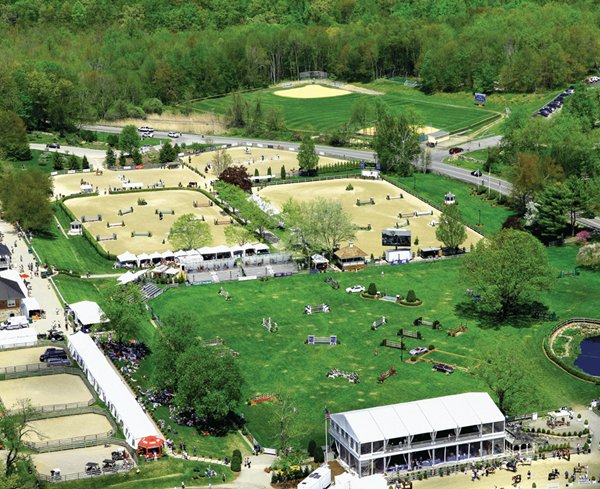 An aerial view of the farm during the American Gold Cup shows the grand prix field surrounded by trade-fair tents. | Courtesy, Stephen Roe
An aerial view of the farm during the American Gold Cup shows the grand prix field surrounded by trade-fair tents. | Courtesy, Stephen RoeOld Salem Gold
“The American Gold Cup began as one of the first important grand prix events in the U.S.,” says Michael Morrissey, president of Stadium Jumping Inc., the event’s longtime show manager. For the past 45 years, he says, “it has featured our country’s most legendary equestrian athletes.” Started by Michael’s uncle, Gene Mische, at the 1970 Cleveland Horse Show in Chagrin Falls, Ohio, the prestigious event has always concluded with an exciting world-class grand prix competition. Conrad Homfeld, who went on to win the 1984 Olympic individual silver and team gold medals, was victorious the first year. Ten other Olympians and six World Cup champions have won it since then.
Winning the Gold Cup has probably been on the bucket list of every top show jumper in the country. Michael Matz and Rodney Jenkins dominated the grand prix in its first decade. Rodney won in 1972 with Balbuco and then the next three consecutive years with the great Idle Dice. He scored his fifth win in 1985 with The Natural. Michael won with Grande in 1977 and then with Jet Run in ’78 and ’79. He returned 20 years later to win the Gold Cup with Judgement. Melanie Smith-Taylor also won the event three times in the ’70s and ’80s, once with Radnor II and twice with Calypso.
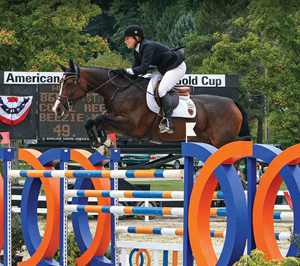 Beezie Madden and Coral Reef Via Volo won the 2010 American Gold Cup in Cleveland, Ohio. | © Kenneth Kraus/Phelps Media
Beezie Madden and Coral Reef Via Volo won the 2010 American Gold Cup in Cleveland, Ohio. | © Kenneth Kraus/Phelps MediaIn the 1990s, Anne Kursinski won the Gold Cup four times in six years on Starman, Top Seed, Eros and Dynamite. Other notable winners over the decades have included Steve Stephens, Leslie Howard, Joe Fargis, Norman Dello Joio, Chris Kappler and Beezie Madden. The event hasn’t been won by a Thoroughbred since 1994 and it has been won by only one American Quarter Horse, Threes and Sevens, ridden by Peter Leone in 1988.
Over the years, the American Gold Cup changed locations several times, first to Tampa, Florida, from 1971 to 1972, then to JFK Stadium in Philadelphia, Pennsylvania, from 1973 to 1979, and the Devon Showgrounds in Pennsylvania from 1980 to 2005. It returned to its original grounds in Chagrin Falls in 2006 but struggled to draw top riders. After skipping two of the next five years, the Gold Cup found a permanent home at Old Salem Farm in New York in 2012.
The newly renovated grounds at Old Salem were a perfect fit for this CSI4*–W event, which now spans five days in September and includes five Longines FEI Rankings classes as well as many other Open, Children, Adult and Amateur Jumper classes. This year, the show was selected as a leg of the Longines FEI World CupTM North American League. Prize money for the final event, the Longines FEI World CupTM Jumping New York, will be $215,000—a significant increase from the inaugural event’s $15,000 award. Last year, the show attracted more than 6,000 spectators. This year’s event will also host the Zone 2 ASPCA Maclay Regional Championships.
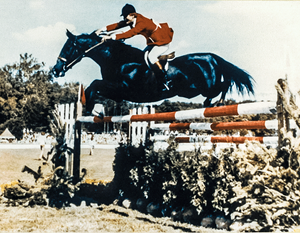 Rodney Jenkins and Idle Dice won the American Gold Cup three years in a row in the early 1970s. | Courtesy, Stadium Jumping Inc.
Rodney Jenkins and Idle Dice won the American Gold Cup three years in a row in the early 1970s. | Courtesy, Stadium Jumping Inc.“We are very proud that the North American Riders Group named the American Gold Cup their top event in the U.S.,” says Michael, “and that it stands today as one of the most significant show- jumping events in the country.”
This article originally appeared in the October 2015 issue of Practical Horseman.







